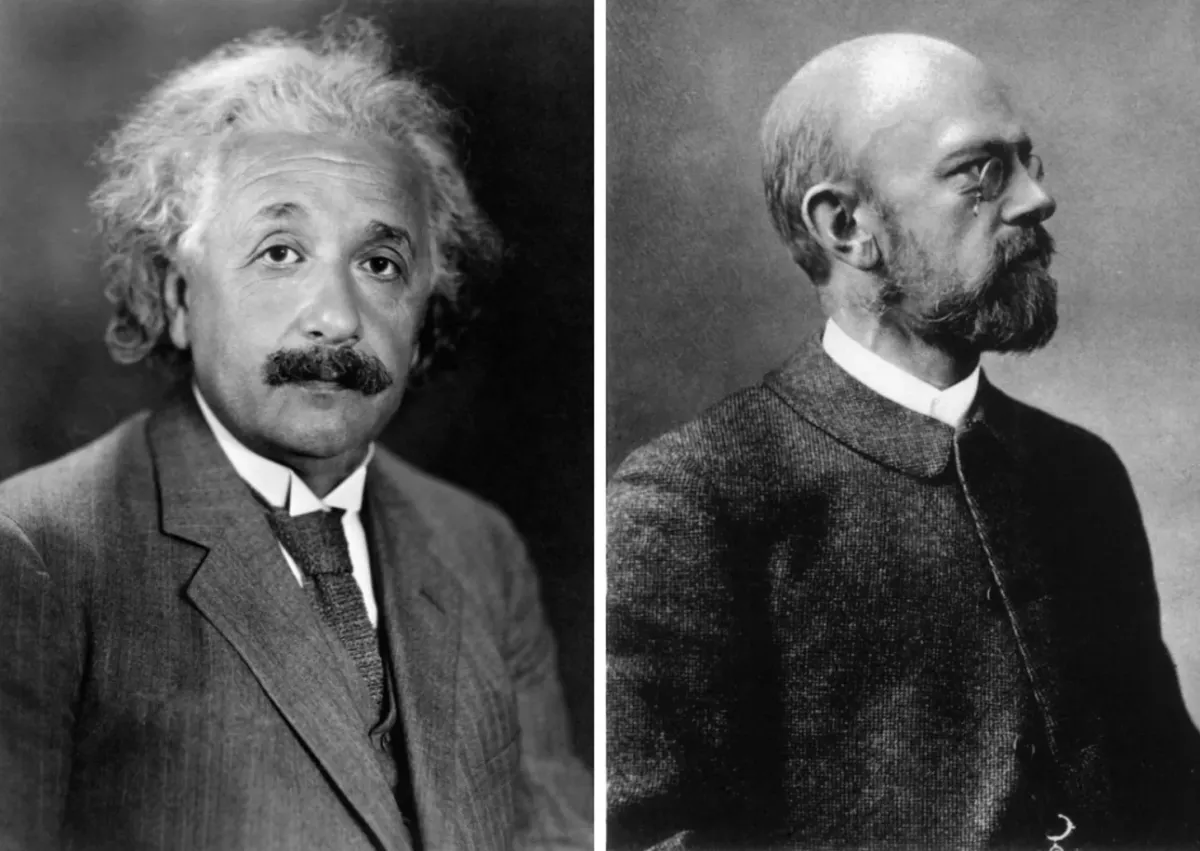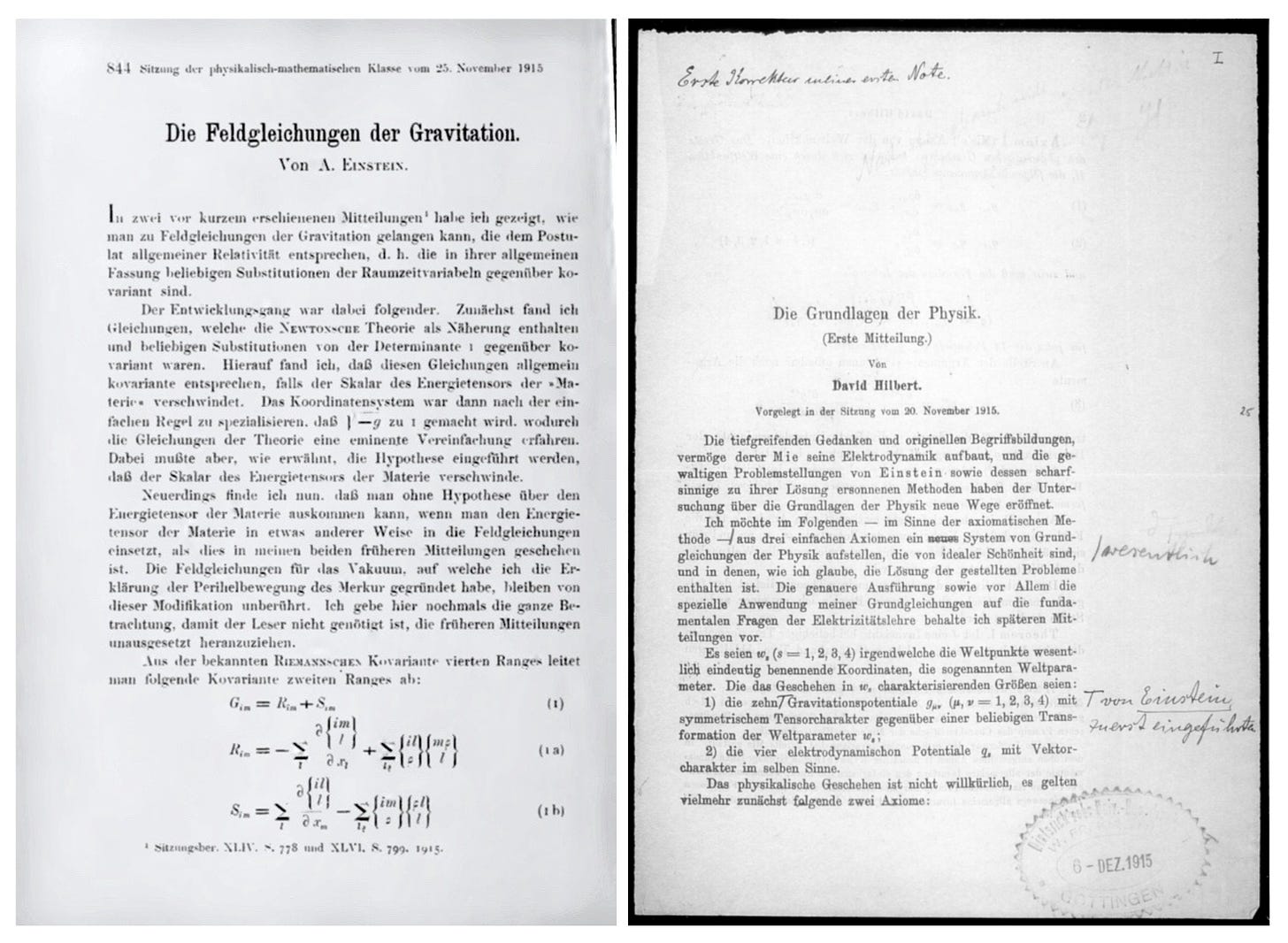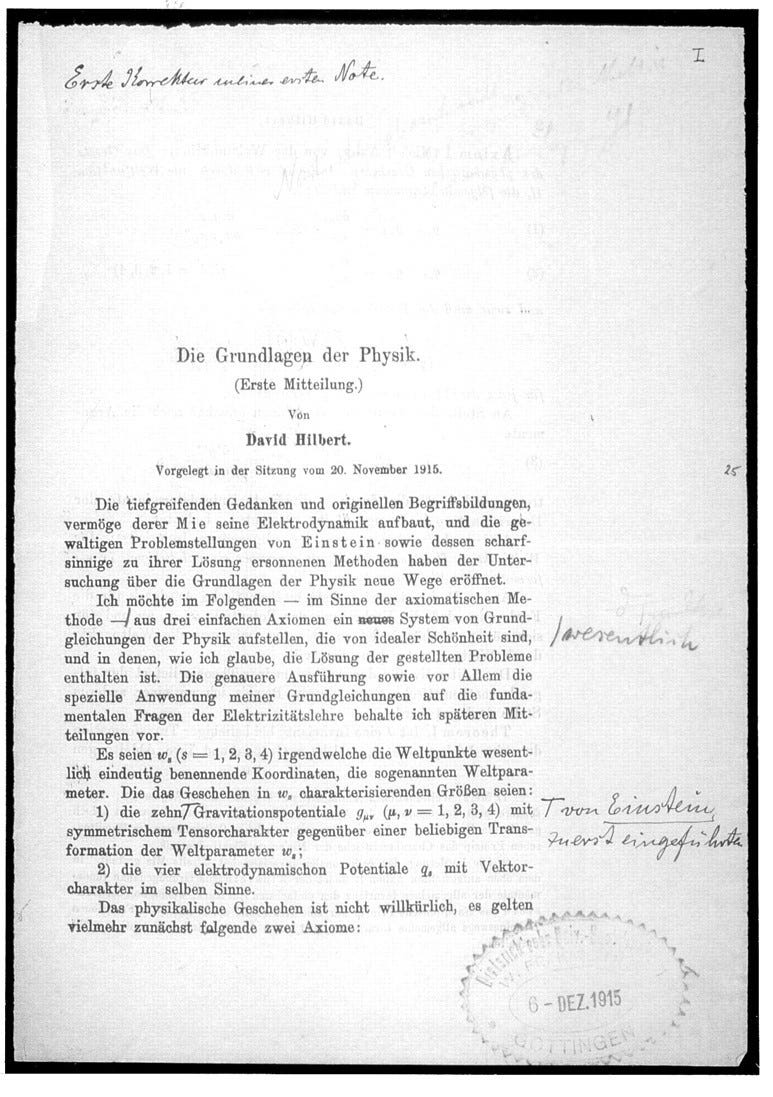Einstein and Hilbert’s Relativity Race
The published version of a talk by mathematician David Hilbert (1862-1943), dated the 20th of November 1915 is entitled ‘Die Grundlagen der Physik’ (“On the Foundations of Physics”).

The published version of a talk by mathematician David Hilbert (1862-1943), dated the 20th of November 1915 is entitled ‘Die Grundlagen der Physik’ (“On the Foundations of Physics”). It was held five days before Einstein’s momentous paper ‘Die Feldgleichungen der Gravitation’ (“The Field Equations of General Relativity”) establishing the mathematical foundation for general relativity. Hilbert’s talk presented a theory of gravitation including field equations describing the fundamental interactions of gravity as a result of spacetime being curved by mass and energy. It was eventually published on the 31st of March 1916.
Albert Einstein (1879-1955) had by November of 1915 been working on the theory of general relativity since his publication of the first paper on special relativity in 1905. However, it would take him ten years to generalize the theory so that it would relate the curvature of spacetime to the energy and momentum of whatever matter and radiation was present. Einstein’s field equations—the system of differential equations that specify general relativity—describe this relationship and were the last missing piece to his epic puzzle.

Generally acknowledged to be the greatest mathematician of his era, Hilbert was in the audience when Einstein spoke at Göttingen University about his new theory of gravitation in early 1915. In fact, he had been the one to invite Einstein to speak. In his lecture, Einstein presented his progress and the difficulties he was having with making his field equations generally covariant (independent of their coordinate system). By fall, Einstein had not made any discernible progress. Hilbert, however, through various channels made it known that he was working on his own theory of gravitation, and indeed making progress.
By November, both were furiously working away at providing the correct mathematical foundation for their theories. By the end of the month, they both had. Ever since, the debate has persisted:
Who generalized relativity first, Einstein or Hilbert?
Timeline of Relativity Theory
The history of relativity dates all the way back to Newton’s apple and the discovery of gravitation as a physical force of the universe:
- 1687: Isaac Newton (1643-1727) publishes ‘Philosophiæ Naturalis Principia Mathematica’ (“Mathematical Principles of Natural Philosophy”), outlining, among other theories, Newton’s law of universal gravitation.
- 1706: Newton notes, as Query I in Book III of his collection of books called The Queries:“Do not Bodies act upon Light at a distance, and by their action bend its Rays; and is not this action (ceteris paribus) strongest at the least distance?”
- 1861–62: James Clerk Maxwell (1831-79) publishes the first forms of Maxwell’s equations describing how electric and magnetic fields are generated by charges, currents and changes in their fields.
- 1883: Ernst Mach (1838-1916) publishes ‘Die Mechanik in ihrer Entwickelung’ (“Mechanics and Its Evolution”) where he criticizes the “monstrous [Newtonian] notion of absolute space”.
Einstein, age 18, was made aware of Mach’s book by his friend Michele Besso (1873-1955) in 1897 while a student at Zürich Polytechnic.
- 1904: At the International Congress of Arts and Science St. Louis, mathematician Henri Poincaré declares the necessity to modify Newton’s gravity theory in order to make it consistent with the later findings of Maxwell, Hendrik Lorentz (1853-1928) and others.
- 1905: Einstein publishes his Annus Mirabilis papers, including ‘Zur Elektrodynamik Bewegter’ (“On the Electrodynamics of Moving Bodies”) where special relativity first appears, uniting time, distance, mass and energy with electromagnetism in a single theory, omitting however, the force of gravity.
- 1907: While sitting in a chair in the patent office in Bern, Einstein experiences “the happiest thought of his life” that “for an observer falling freely from the roof of a house there exists — at least in his immediate surroundings — no gravitational field”. Published in the paper Über das Relativitätsprinzip und die aus demselben gezogene Folgerungen (“On the Relativity Principle and the Conclusions Drawn from it”), the equivalence principle is born. In the same paper, Einstein also derives the gravitational redshift and notes, by deriving a formula for the velocity of light along the direction ξ of a constant gravitational field, that “the light rays which do not run in the ξ direction are bent by the gravitational field”.
In the period 1908–11 Einstein moved away from working on relativity, focusing more or less solely on what we now know as quantum theory: the definitions of light quanta and blackbody radiation. He returns to the study of gravitation in June of 1911 after a four month stay in Prague (Toderov, 2005).
- 1912: Mathematician Hilbert turns his focus from linear integral equations to mathematical physics, beginning work to axiomatize the new theory of the electron originally put forth by Gustav Mie (1868-1957).
- 1913: Einstein, in collaboration with Professor of Geometry at ETH Marcel Grossmann (1878-1936), publishes the paper ‘Entwurf einer verallgemeinerten Relativitatstheorie und einer Theorie der Gravitation’ (“Outline of a Generalized Theory of Relativity and of a Theory of Gravitation”) describing the equivalence principle by way of the now well-known elevator-analogy: “An observer enclosed in a an elevator cannot know whether the box is at rest in a static gravitational field, or in accelerated motion, maintained by forces acting on the box in a space that is free of gravitational fields.”, albeit rejecting the possibility of formulating a generally covariant theory on the grounds that it “violates physical requirements”.
- 1914: Einstein publishes the 56-page paper Die formale Grundlage der allgemeinen Relativitätstheorie (“The Formal Foundation of the General Theory of Relativity”) where he recounts and expands on the “Entwurf” (Outline) written a year before with Grossmann. The paper specifies what has been later become known as Einstein’s “scalar theory of gravitation”. Einstein later communicates that he was discontent with the theory, mainly for three reasons: 1. Its restricted covariance doe†s not include uniform rotations; 2. The precession (change in orientation) of the perihelion (closest point of a planet to its star) of Mercury coming out to 18 arcseconds rather than the observed 45 arcseconds per century; and 3. That his proof of the uniqueness of the gravitational Hamiltonian is in fact, incorrect.
- Summer 1915: At the invitation of Hilbert, Einstein spends a week at Göttingen University where he delivers six two-hour lectures after which he declares to Wander Johannes de Haas (1878-1960): “To my great joy, I succeeded in convincing Hilbert and Klein completely” and to physicist Arnold Sommerfeld (1868-1951): “I am enthusiastic about Hilbert”. Einstein’s enthusiasm appears reciprocated, as following the lectures Hilbert nominates Einstein for the Bolyai Prize of 1915 for “the highest mathematical spirit of his achievements”.
- Autumn 1915: Sommerfeld communicates to Einstein that Hilbert is also dissatisfied with the “Entwurf” scalar theory of gravitation that Einstein published in 1914. Hilbert is at this point working on his own theory of gravitation, entitled Die Grundlagen der Physik (“The Foundations of Physics”).
“Was Einstein going to let someone else share with him the fruit of years of hard work and great inspiration? Not he! At 36, he can still fight!” — Ivan T. Todorov (2005)
November 1915
And so, by November 1915, Einstein and Hilbert were both convinced that a generally covariant relativity theory would indeed be necessary and achievable. The following account of what happened in November is based largely on the narration Einstein and Hilbert: The Creation of General Relativity by Todorov (2005).
November 4th
Einstein communicates to the Preussian Academy of Sciences a paper entitled Zur allgemeine Relativitätstheorie (“The Theory of General Relativity”) where he for the first time in public rejects his “Entwurf” scalar theory of gravitation of 1914, proposing in its place a new fundamental equation. Regarding his scalar theory the year before, he states:
“I lost trust in the field equations I had derived, and instead, looked for a way to limit the possibilities in a natural way. In this pursuitI arrived at the demand of general covariance, a demand from which I parted, though with a heavy heart, three years ago when i worked together with my friend Grossmann.” — Einstein, early November 1915
As Abraham Pais (1918-2000) is later reported to have said, Einstein’s lacking ability to define his field equations in generally covariant form should indeed be quite understandable, as Einstein had been well ahead of his time exploring what Pais aptly called a “no man’s land”.
November 7th
Einstein sends Hilbert the proofs from his November 4th paper, writing that “I recognized four weeks ago that my earlier methods of proof were deceptive”, likely responding to a communication to Sommerfeld that reports Hilbert’s objections to Einstein’s October 1914 paper. Interestingly, Einstein finishes the letter by asking Hilbert:
“I am curious whether you will be well disposed towards this solution”
Einstein’s new solution was however still not generally covariant, assuming that the determinant of the metric tensor was a constant (-1). Although Hilbert’s letter in response has been lost, it is fair to assume from their later communication and Einstein’s further revision of the theory that Hilbert was in fact not “well disposed” towards the solution.
November 11th
A week later, Einstein again communicates to the Preussian Academy, under the same title as the week before, rejecting his initially proposed equation and instead putting forth a new equation, likely based on Hilbert’s feedback. Einstein now, suddenly, proposes a generally covariant equation:

However, which only coincides with his final (correct) equation if the stress-energy tensor T (and hence also R) is traceless, i.e. that the sum of the elements on the main diagonal of the matrix trace are zero), which is true for Maxwell’s electrodynamics. The very next day, Einstein sends Hilbert a second letter, announcing that with his November 11th note, he has finally found the correct formulation for his field equations, that now satisfy general covariance.
November 14th
Hilbert responds to Einstein’s letter a few days later with a long note. In it, he notes that he is himself excited about his own“axiomatic solution of your grand problem”, noting that “insofar as I understand your new paper, the solution given by you is completely different from mine” from Einstein’s (Todorov, 2005 p. 8). He invites Einstein to come to Göttingen to hear him present his theory, even inviting him to spend the night in his home.
November 15th
Einstein answers Hilbert’s letter asking for copies of the proofs from Hilbert’s lecture and regretfully declining Hilbert’s invitation to attend his lecture due to illness and exhaustion.
November 18th
Hilbert must have responded to Einstein’s request and sent him a copy of the proofs, because by the 18th of November, Einstein again writes to Hilbert, stating “The system of equations given by you agrees — as far as I can tell, exactly with what I found in recent weeks and submitted to the Academy.” He next goes on to mention, somewhat competitively, that he and Grossman had been aware of the equation of his November 11th paper for three years, but rejected it due to its incompatibility with Newtons Law (meaning Poisson’s field equation) in the Newtonian limit. On the same day, Einstein sends his third communication to the academy for the month, entitled Erklärung der Perihelbewegung des Merkur aus der allgemeinen Relativitätsheorie (“Explanation of the Perihelion Motion of Mercury from the General Theory of Relativity”), providing a calculation of the precession of the perihelion of Mercury which “comes out to the correct, observed 45".
As Todorov notes, two remarks are in order based on Einstein’s paper. First, Einstein is not correct in his assertion that his equation

is equivalent to Hilbert’s equation from his November 20th paper

The two are only equivalent for one another when homogeneous, i.e. when the stress-energy tensor is equal to zero. Second, Einstein indeed does derive the correct numerical value for the precession of the perihelion of Mercury. However, he does so from the not exactly correct equation of his November 11th paper, by solving the equation for a case where the stress-energy tensor is 0 in the post-Newtonian approximation (allowing for point singularities) (Todorov, 2005. p. 9).
November 19th
On the 19th, Hilbert responds to Einstein by congratulating him for having found the correct precession of the perihelion of Mercury, adding: “If I could calculate as quickly as you, then the electron would have to capitulate in the face of my equations and at the same time the hydrogen atom would have to offer its excuses for the fact that it does not radiate” (Pais 1992, p. 260).
November 20th
Hilbert presents his work to Gesellschaft der Wissenschaften, the Academy in Göttingen. In the published article of his talk, he begins by acknowledging Einstein’s work, stating: “Einstein […] has brought forth profound thoughts and unique conceptions, and invented ingenious methods for dealing with them”, however also introducing ambiguity, writing “Following the axiomatic method, in fact from two simple axioms, I would like to propose a new system of the basic equations of physics. They are of ideal beauty and I believe they solve the problems of Einstein and Mie at the same time”. Hilbert then proceeds to derive the correct equations for the variational principle assuming general/reparametrization covariance and a second order equation for the metric tensor g_μν.
November 25th
In Einstein’s fourth and final note to the Academy in November 1915, ‘Die Feldgleichungen der Gravitation’ (“The Field Equations of Gravitation”) he rejects both of his earlier proposed fundamental equations, and submits, finally, what we now know to be the correct equations describing his general theory of relativity, albeit without a derivation of the correct stress-energy tensor his previous versions had so critically been lacking:

This time, his equation is exactly equivalent to Hilbert’s, since they both imply R+κT = 0. Einstein does not refer to Hilbert’s work in the paper.
The Dispute
Who got there first?
Einstein’s paper featuring the correct forms of the field equations is dated November 25th 1915. Hilbert’s is dated November 20th. It is known that Hilbert sent Einstein a copy of his work which most likely reached Einstein before he submitted his own paper (Kennefick, 2015). For a long time, it was believed that Einstein and Hilbert found the field equations of gravity independently. This is now fairly widely disputed. The question of priority thus still remains.
The Case for Priority to Hilbert

Advocates for Hilbert receiving priority have (naturally) suggested that Einstein derived some benefit or hints from his (Hilbert’s) letters, and that those had helped him arrive at the trace term of the field equations, and that if so, that Einstein should have acknowledged this in his paper. Einstein does not.
In fact, his November 25th 1915 paper only contains two references to prior work, neither of which is related to the trace term. The fact that Einstein, somewhat ‘out of the blue’ (without derivation) provides the correct form for the term in his paper, thus lends credence to those who are skeptical that he arrived at the correct form independently. Physicist Kip Thorne (1940-) in his book Black Holes and Time Warps: Einstein’s Outrageous Legacy (1994) stated quite definitely his view that “Remarkably, Einstein was not the first to discover the correct form of the law of warpage [. . . .] Recognition for the first discovery must go to Hilbert.”. In Albert Einstein: A Biography*, the author Albrecht Fölsing argues, although seemingly convinced that Einstein and Hilbert arrived at the correct forms independently, that:
In November, when Einstein was totally absorbed in his theory of gravitation, he essentially only corresponded with Hilbert, sending Hilbert his publications and, on November 18, thanking him for a draft of his article. Einstein must have received that article immediately before writing this letter. Could Einstein, casting his eye over Hilbert’s paper, have discovered the term which was still lacking in his own equations, and thus ‘nostrified’ Hilbert?
The Case for Priority to Einstein

In Albert Einstein: A Biography*, author Albrecht Fölsing describes that Einstein “..complained to Heinrich Zangger about what he evidently interpreted as an attempt [by Hilbert] at plagiarism”. Yet, Fölsing, in agreement with the majority of physicists and historians of science at the time (1993), appears to believe that in fact Einstein and Hilbert arrived at the field equations independently and in parallel, but that priority in terms of their discovery in final form should go to Einstein. Norton (1986) provides a very well documented (56-page) argument for an independent road to the correct equations for Einstein, amongst other sources studying Einstein’s Zürich notebook from the time of his November work.
The perhaps most substantial evidence for the case of priority to Einstein are copies of Hilbert’s proofs and the original manuscript of his November 20th communication, discovered by Leo Corry in Hilbert’s archives. The material became known with the publication of an article in Science Magazine entitled ‘Belated Decision in the Hilbert-Einstein Priority Dispute’ (Corry et al, 1997).

Both the known proofs and the final version of Hilbert’s first communication with the Gesellschaft der Wissenschaften in Göttingen are dated “submitted on 20 November 1915”. The unearthed copies of the proofs, marked in Hilbert’s handwriting, however claim “First proofs of my first note”, bearing a stamped date of December 6th 1915 — implying that Hilbert indeed communicated revisions to the academy after the publication of Einstein’s paper on November 25th. Close comparison between the November 20th communication, the copies of the proofs dated December 6th and Hilbert’s published paper confirm this. In terms of consequences for the priority dispute, the findings are quite clear. Of the differences between Hilbert’s November 20th communication and the published paper, Corry et al (1997) highlight, quite definitively, that:
- In Hilbert’s November 20th communication, he states that his theory cannot be generally covariant and so that in addition to 10 generally covariant equations, there must be four additional non-covariant equations to guarantee causality.
- In Hilbert’s November 20th communication, his equation includes a gravitational term [√gK] and he indicates that the gravitational part of the field equations take the form of the variational derivative of the gravitational term with respect to the metric. He does however, not give the explicit form of the gravitational part. He does so in the published version (submitted after reading Einstein’s paper).
The details of the differences between the two manuscripts, and their implications are best read in the original Science Magazine article.
What is Indisputable
“Quite naturally, and in accord with Hilbert’s view of things, the resulting law of warpage was quickly given the name the Einstein field equation rather than being named after Hilbert. Hilbert had carried out the last few mathematical steps to its discovery independently and almost simultaneously with Einstein, but Einstein was responsible for essentially everything that preceded those steps…” — Kip Thorne, 1994
It is indisputable that Hilbert, like all of his other colleagues, acknowledged Einstein as the sole creator of relativity theory (Fölsing, 1993). This is confirmed in many places, even on the first page of Hilbert’s publication. On December 4th, Hilbert even nominated Einstein for election as a corresponding member of the Göttingen Mathematical Society. Despite this, there was indeed a period of tension between the two, coming to a head on December the 20th with Einstein writing to Hilbert offering a reconciliation:
“There has been a certain resentment between us, the cause of which I do not want analyze any further. I have fought against the feeling of bitterness associated with it, and with complete success. I again think of you with undiminished kindness and I ask you to attempt the same with me. It is objectively a pity if two guys that have somewhat liberated themselves from this shabby world are not giving pleasure to each other.”
About 35 years after these events logician Kurt Gödel (1902-78) presented Einstein with a new solution to his field equations, on the occasion of Einstein’s 70th birthday. The story of Gödel’s investigation and the implications of his findings is discussed in a seperate newsletter available here.
This essay is based largely on the wonderful 1992 colloquium talk by Ivan T. Todorov, later expanded and published as:
- Todorov, I. T. 2005. Einstein and Hilbert: The Creation of General Relativity.
References
- Corry, L. Renn, J. & Stachel, J. 1997. 'Belated Decision in the Hilbert-Einstein Priority Dispute. Science Magazine
- Fölsing, A. 1997. Albert Einstein: A Biography*. Viking Adult.
- Kennefick, D. & Blume, M. 2015. Reviewing Einstein. Science Magazine
- Pais, A. 1992. Niels Bohr’s Times: In Physics, Philosophy and Polity. Physics Today 45(3), p. 65.
- Todorov, I. T. 2005. Einstein and Hilbert: The Creation of General Relativity. arXiv preprint physics/0504179.
* This essay contains Amazon affiliate links





